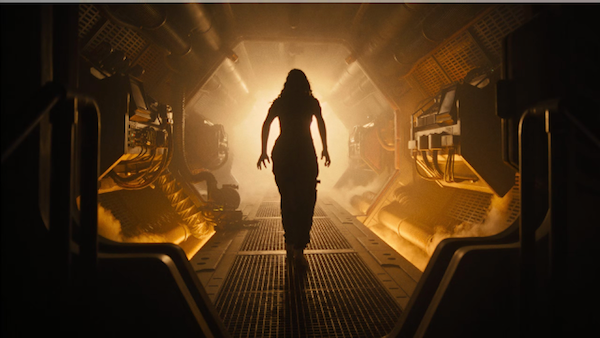Movie review by Greg Carlson
Set between the events of the original 1979 “Alien” and its propulsive 1986 sequel “Aliens,” the latest installment in the long-running series is called “Alien: Romulus.” Uruguayan-born director and co-writer Fede Alvarez, no stranger to franchise filmmaking, understands Disney/Fox’s assignment: “Romulus” functions as a blend of standard genre beats and as a loose refresh of Ridley Scott’s classic. The result is a mostly entertaining homage enlivened by lead Cailee Spaeny (overcoming an underwritten role) and her adopted synthetic Andy, a reprogrammed android played by David Jonsson. Newcomers to the dystopia should be intrigued enough to seek out the other movies. Seasoned fans will be content spotting all the references, in-jokes, and callbacks to other “Alien” media.
In the decades since Scott introduced viewers to Sigourney Weaver’s warrant officer Ellen Ripley and the other ill-fated members of the commercial bolt-bucket Nostromo, many of the filmmaker’s touches and flourishes have been reproduced ad infinitum. The essential “Old Dark House” structure – in which several disposable characters are stranded and picked off one by one – is the plot gift that has kept on giving since long before Dan O’Bannon and Ronald Shusett decided to play with it. Scott’s blend of horror and science fiction is meticulously paced and beautifully framed; the anxiousness and dread emanate from a sense of “everything in its right place.”
It also didn’t hurt to have the sexually-charged biomechanical nightmares of designer H. R. Giger at the heart of the movie’s unsettling body horror: the parasitic birth cycle that introduced the egg to facehugger to chestburster to xenomorph stages as an unholy corruption of a butterfly’s metamorphosis. No wonder, then, that the “Alien” universe has spilled from the big screen to encompass toys, video games, short films, novels, comics, web content, and a forthcoming episodic television series. As one of many players in the “Alien” sandbox, Alvarez can be commended for expressing the sense of stylish grandeur in his renderings of outer space’s vast oceans and the claustrophobia of being trapped in a labyrinth of metallic hallways infested by hostile critters.
Unfortunately, Alvarez and fellow writer and frequent creative partner Rodo Sayagues ignore the value of giving the supporting characters unique personalities or even hints of interior lives. “Alien” fans of a certain age can identify the little things that distinguished Ripley, Dallas, Kane, Lambert, Parker, Brett, and Ash (Jonesy, too). Roger Ebert pointed out that older actors added to the working class verisimilitude. The most significant exception in “Romulus” comes, unsurprisingly, from Jonsson’s Andy. Members of the fan community continue to argue over the merits of resurrecting a familiar face in a kind of cameo, but the androids across the entirety of “Alien” media are the most consistently complex presence.
It would be unfair to say more about Andy’s crucial function within the arc of “Romulus,” but Jonsson, so warm and winning in “Rye Lane,” sinks his teeth into the mercurial and mysterious simulacrum. Spaeny’s role, very much molded after Ripley – down to the exposed-flesh vulnerability of the parallel climaxes – is less meaty than the one enjoyed by her character’s companion. The exciting performer, whose recent contribution to “Civil War” as photojournalist Jessie Cullen also balanced physically demanding action and contemplative self-reflection, holds her own in the cruel hellscape wrought by the Weyland-Yutani Corporation.
